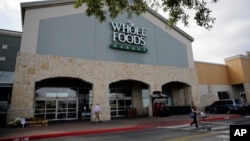Amazon announced Friday that it will purchase Whole Foods for $13.7 billion. It is the e-commerce giant’s biggest acquisition to date, and highlights the company’s continued attempt to penetrate the $800 billion grocery industry.
“Millions of people love Whole Foods Market because they offer the best natural and organic foods, and they make it fun to eat healthy,” said Amazon co-founder and CEO Jeff Bezos in a statement. “Whole Foods Market has been satisfying, delighting and nourishing customers for nearly four decades – and they’re doing an amazing job and we want that to continue.”
Whole Foods Market was founded in 1978 in Austin, Texas. Despite nagging concerns that the high-end grocery chain inflated prices, it experienced steady growth. It has landed on the Fortune 500 list every year since 2005 and employs more than 70,000 people in the United States, Canada and the United Kingdom. The grocer will keep its corporate office in Austin and continue to use the Whole Foods name after the sale.
For its part, Amazon has strained to enter the grocery market for years. Initially an internet bookshop, Amazon began delivering non-perishable food items like cereal and soup in 2006, prompting derision from the grocery industry. “I’m a little baffled by this,” said an analyst in 2006. “Economically I just don’t know how it makes much sense.”
The doubters appeared right. By early 2017, only 4.2 percent of regular Amazon shoppers used its grocery home delivery service. “Online grocery is failing,” analyst Kurt Jetta told The New York Times in March.
In response, Amazon, an online retailer, has built some of the kind of stores it has disrupted – brick and mortar shops. Last year, it opened two small stores in Seattle where drivers can seamlessly pick up produce without leaving their cars. The Whole Foods acquisition continues the e-retailer’s awkward embrace of physical stores. The deal is expected to close in the second half of 2017.





